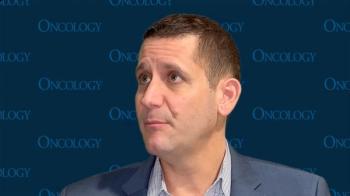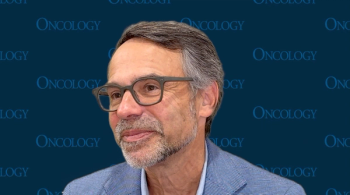
Tony S. Mok, MD, Reviews Capmatinib Plus Pembrolizumab in Previously Untreated NSCLC
Tony S. Mok, MD, spoke about the use of capmatinib plus pembrolizumab in patients with previously untreated non–small cell lung cancer who were MET unselected and had PD-L1 expression of 50% or more.
At the
Of evaluable patients treated, the objective response rate was 15.7% (95% CI, 7.0%-28.6%) in the combination arm and 28.0% (95% CI, 12.1%-49.4%) with pembrolizumab alone. Additionally, the disease control rates were 56.9% vs 56.0% in the combination and pembrolizumab alone arms, respectively.
Transcript:
We know that pembrolizumab is an anti–PD-1 [agent] that had been a current standard [of treatment] for patients who have over 50% expression of PD-L1. On the other hand, capmatinib is a rather potent MET inhibitor. The MET inhibitor can inhibit MET in the cancer cell, but at the same time it may also affect MET in the T cell. There are preclinical data suggesting that the inference in the T cell can potentially affect the T cell ability to kill the cancer cell. Based on this so-called background hypothesis, we combined a potent MET inhibitor with pembrolizumab for patients who are over 50% of PD-L1 expression.
This is a randomized phase 2 study, where the objective is to see whether there is a signal that may improve efficacy. Unfortunately, in the sample that we collected, there is a no signal of any improvement in the progression-free survival. On the other hand, the patient who received capmatinib in combination [with pembrolizumab] had additional toxicity. They are mostly MET related, like edema and hepatic toxicity. Overall, there is added toxicity but not much signal that it may improve efficacy. That’s why the study was terminated slightly early.
Reference
Mok T, Cortinovis D, Majem M, et al. Efficacy and safety of capmatinib plus pembrolizumab in treatment (tx)-naïve patients with advanced non–small cell lung cancer (NSCLC) with high tumor PD-L1 expression: Results of a randomized, open-label, multicenter, phase 2 study. J Clin Oncol. 2022;40(suppl 16):9118. doi:10.1200/JCO.2022.40.16_suppl.9118
Newsletter
Stay up to date on recent advances in the multidisciplinary approach to cancer.
















































































